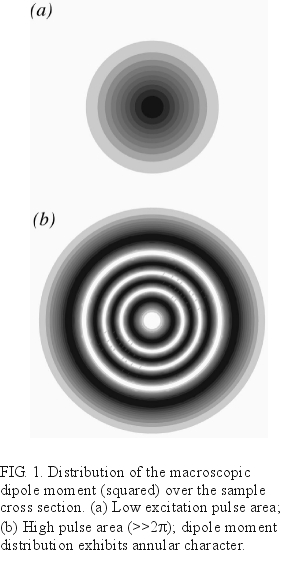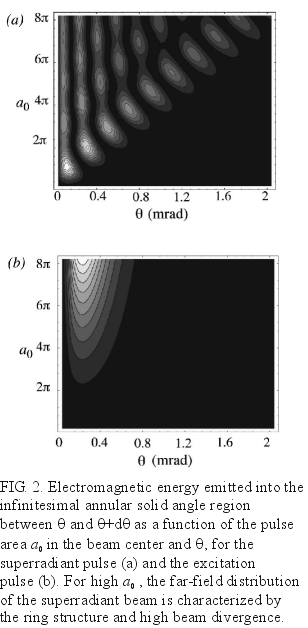Superradiant self-diffraction
Alexander Lvovsky, Sven
Hartmann
For a Physical Review article, click here
In his classic paper on superradiance [1], R. H. Dicke has considered
a case when a large number of dipoles oscillating in phase are concentrated
in a very small (<l3 ) volume.
In experimental practice this situation is quite uncommon, and in later
works on superradiance (see, for example, [2]) Dicke's analysis has been
modified to account for larger excited volume. Modern treatment usually
regards the excited volume as cylindrical, with all the elementary dipoles
equally excited. But this assumption is not, generally speaking, correct
either. The macroscopic dipole moment induced in a sample by a highly energetic
excitation pulse of nonuniform (e.g. Gaussian) profile forms a ring pattern,
where highly excited areas alternate with regions where the Rabi area of
the excitation field is a multiple of 2p and
the excitation is weak (Fig. 1).

 The
superradiant beam, generated by the macroscopic dipole moment of such complicated
structure, undergoes self-diffraction, resulting in high beam divergence
and complex pattern of the far field radiation (Fig. 2). We have performed
a detailed theoretical analysis of superradiant self-diffraction patterns
and found a number of interesting properties they possess. We have also
proven a theorem stating that for sufficiently smooth excitation profiles
in an optically thin sample, the total power of superradiant emission is
proportional to the integral, over the excited volume, of the macroscopic
dipole moment squared. A curious consequence is that for such nonuniformly
excited samples, the total power of cooperative emission is given by the
same function of excitation pulse area a0 as the total
power of noncoherent fluorescent emission as a function of a0/2.
The
superradiant beam, generated by the macroscopic dipole moment of such complicated
structure, undergoes self-diffraction, resulting in high beam divergence
and complex pattern of the far field radiation (Fig. 2). We have performed
a detailed theoretical analysis of superradiant self-diffraction patterns
and found a number of interesting properties they possess. We have also
proven a theorem stating that for sufficiently smooth excitation profiles
in an optically thin sample, the total power of superradiant emission is
proportional to the integral, over the excited volume, of the macroscopic
dipole moment squared. A curious consequence is that for such nonuniformly
excited samples, the total power of cooperative emission is given by the
same function of excitation pulse area a0 as the total
power of noncoherent fluorescent emission as a function of a0/2.
This existence of superradiant self-difraction is made manifest by a
two-pulse photon echo experiment where the second pulse is spatially much
broader than the first and has a small Rabi area. As a function of the
intensity of the first excitation pulse, we measure the on-axis and off-axis
echo intensity and find, in agreement with our calculations, that the two
behave differently.
1. R. H. Dicke, Phys. Rev. 93, 99 (1954)
2. D. Abella, N. A. Kurnit, and S. R. Hartmann, Phys. Rev. 141, 391
(1966)

 The
superradiant beam, generated by the macroscopic dipole moment of such complicated
structure, undergoes self-diffraction, resulting in high beam divergence
and complex pattern of the far field radiation (Fig. 2). We have performed
a detailed theoretical analysis of superradiant self-diffraction patterns
and found a number of interesting properties they possess. We have also
proven a theorem stating that for sufficiently smooth excitation profiles
in an optically thin sample, the total power of superradiant emission is
proportional to the integral, over the excited volume, of the macroscopic
dipole moment squared. A curious consequence is that for such nonuniformly
excited samples, the total power of cooperative emission is given by the
same function of excitation pulse area a0 as the total
power of noncoherent fluorescent emission as a function of a0/2.
The
superradiant beam, generated by the macroscopic dipole moment of such complicated
structure, undergoes self-diffraction, resulting in high beam divergence
and complex pattern of the far field radiation (Fig. 2). We have performed
a detailed theoretical analysis of superradiant self-diffraction patterns
and found a number of interesting properties they possess. We have also
proven a theorem stating that for sufficiently smooth excitation profiles
in an optically thin sample, the total power of superradiant emission is
proportional to the integral, over the excited volume, of the macroscopic
dipole moment squared. A curious consequence is that for such nonuniformly
excited samples, the total power of cooperative emission is given by the
same function of excitation pulse area a0 as the total
power of noncoherent fluorescent emission as a function of a0/2.